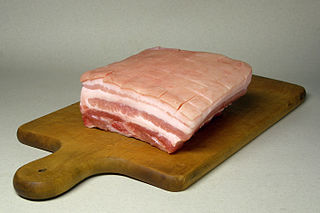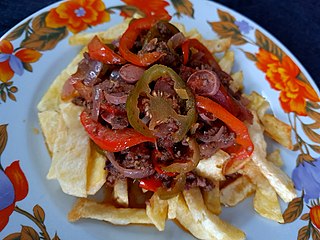
Argentine cuisine is described as a cultural blending of Mediterranean influences brought by the Spanish during the colonial period and, later, by Italian and Spanish immigrants to Argentina during 19th and 20th centuries, with influences from a further cultural blending of criollos with the Indigenous peoples of Argentina.

Botifarra is a type of sausage and one of the most important dishes of the Catalan cuisine.

Latin American cuisine is the typical foods, beverages, and cooking styles common to many of the countries and cultures in Latin America. Latin America is a highly diverse area of land whose nations have varying cuisines. Some items typical of Latin American cuisine include maize-based dishes arepas, pupusas, tacos, tamales, tortillas and various salsas and other condiments. Sofrito, a culinary term that originally referred to a specific combination of sautéed or braised aromatics, exists in Latin American cuisine. It refers to a sauce of tomatoes, roasted bell peppers, garlic, onions and herbs. Rice and beans are also staples in Latin American cuisine.

Arepa is a type of food made of ground maize dough, eaten in the northern region of South America since pre-Columbian times, and notable primarily in the cuisine of Colombia and Venezuela, but also present in the cuisines of Bolivia and other countries.

Pork belly is a boneless and fatty cut of meat from the belly of a pig. Pork belly is particularly popular in Hispanic, Chinese, Danish, Norwegian, Korean, Thai and Filipino cuisine.

The ensaimada is a pastry product from Mallorca, Balearic Islands, Spain. It is a common cuisine eaten in Southwestern Europe, Latin America and the Philippines. The first written references to the Mallorcan ensaïmada date back to the 17th century. At that time, although wheat flour was mainly used for making bread, there is evidence that this typical pastry product was made for festivals and celebrations.

Hallaca is a traditional meal from Venezuela that resembles the aspect of a tamal. However, the hallaca and the tamal are different in their flavour, texture, ingredients and cultural significance. It consists of corn dough stuffed with a stew of beef, pork, or chicken and other ingredients such as raisins, capers, and olives, fresh onion rings, red and green bell pepper slices. Also vegetarian options with black beans or tofu Hallacas are folded in plantain leaves, tied with strings, and boiled; The dish is traditionally served during the Christmas season and has several regional variants in Venezuela. It has been described as a national dish of Venezuela but it can be found also in variants. Some speculate it originated from the Orinoquia. A characteristic of the hallaca is the delicate corn dough made with consommé or broth and lard colored with annatto. Hallacas are also commonly consumed in eastern Cuba, Trinidad where it is referred to as pastelle, as well as parts of Colombia, Ecuador, Aruba, and Curaçao. In Nicaragua it is known as “Nacatamal”.
Peruvian cuisine reflects local practices and ingredients including influences mainly from the indigenous population, including the Inca, and cuisines brought by immigrants from Europe ; Asia ; and Africa. Without the familiar ingredients from their home countries, immigrants modified their traditional cuisines by using ingredients available in Peru.

Torta is a culinary term that can, depending on the cuisine, refer to cakes, pies, flatbreads, sandwiches, or omelettes.

Jamón is a kind of dry-cured ham produced in Spain. It is one of the most globally recognized food items of Spanish cuisine. It is also regularly a component of tapas.

Sancocho is a traditional broth in several Latin American cuisines. Variations represent popular national dishes in Puerto Rico, Honduras, Ecuador, Colombia, Cuba, Panama, Dominican Republic, Trinidad and Tobago, and Venezuela. It usually consists of large pieces of meat, tubers and vegetables served in a broth.
Venezuelan cuisine is influenced by its European, West African, and indigenous traditions. Venezuelan cuisine varies greatly from one region to another. Food staples include corn, rice, plantains, yams, beans and several meats. Potatoes, tomatoes, onions, eggplants, squashes, spinach and zucchini are also common side dishes in the Venezuelan diet. Ají dulce and papelón are found in most recipes. Worcestershire sauce is also used frequently in stews. Venezuela is also known for having a large variety of white cheese, usually named by geographical region.

Uruguayan cuisine is a fusion of cuisines from several European countries, especially from Mediterranean foods from Spain, Italy, Portugal and France. Other influences on the cuisine resulted from immigration from countries such as Germany and Scotland. Uruguayan gastronomy is a result of immigration, rather than local Amerindian cuisine, because the new colonies did not trust the native Charrúa people. Spanish influences are very abundant: desserts like churros, flan, ensaimadas yoo (Catalan sweet bread), and alfajores were all brought from Spain. There are also all kinds of stews known as guisos or estofados, arroces, and fabada. All of the guisos and traditional pucheros (stews) are also of Spanish origin. Uruguayan preparations of fish, such as dried salt cod (bacalao), calamari, and octopus, originate from the Basque and Galician regions, and also Portugal. Due to its strong Italian tradition, all of the famous Italian pasta dishes are present in Uruguay including ravioli, lasagne, tortellini, fettuccine, and the traditional gnocchi. Although the pasta can be served with many sauces, there is one special sauce that was created by Uruguayans. Caruso sauce is a pasta sauce made from double cream, meat, onions, ham and mushrooms. It is very popular with sorrentinos and agnolotti. Additionally, there is Germanic influence in Uruguayan cuisine as well, particularly in sweet dishes. The pastries known as bizcochos are Germanic in origin: croissants, known as medialunas, are the most popular of these, and can be found in two varieties: butter- and lard-based. Also German in origin are the Berlinese known as bolas de fraile, and the rolls called piononos. The facturas were re-christened with local names given the difficult German phonology, and usually Uruguayanized by the addition of a dulce de leche filling. Even dishes like chucrut (sauerkraut) have also made it into mainstream Uruguayan dishes.

Chilean cuisine stems mainly from the combination of traditional Spanish cuisine, Chilean Mapuche culture and local ingredients, with later important influences from other European cuisines, particularly from Germany, Italy, the United Kingdom and France. The food tradition and recipes in Chile are notable for the variety of flavours and ingredients, with the country's diverse geography and climate hosting a wide range of agricultural produce, fruits and vegetables. The long coastline and the peoples' relationship with the Pacific Ocean add an immense array of seafood products to Chilean cuisine, with the country's waters home to unique species of fish, molluscs, crustaceans and algae, thanks to the oxygen-rich water carried in by the Humboldt Current. Chile is also one of the world's largest producers of wine and many Chilean recipes are enhanced and accompanied by local wines. The confection dulce de leche was invented in Chile and is one of the country's most notable contributions to world cuisine.

The coca is a pastry typically made and consumed in Catalonia, the Aragonese Strip, most of Valencia, the Balearic Islands, Andorra and in French Catalonia.

Puchero is a type of stew originally from Spain, prepared in Yucatán, Mexico, Argentina, Paraguay, Uruguay, Perú, south of Brazil, the Philippines, and Spain, specifically the autonomous communities of Andalusia and the Canary Islands. The Spanish word "puchero" originally meant an earthenware pot, before being extended to mean any vessel, and then the dish cooked in it.

Bolivian cuisine stems from the combination of Spanish cuisine with indigenous ingredients and Aymara traditions, among others, with later influences from Germans, Italians, French, and Arabs due to the arrival of immigrants from those countries. The traditional staples of Bolivian cuisine are corn, potatoes, quinoa and beans. These ingredients have been combined with a number of staples brought by the Spanish, such as rice, wheat, and meat, including beef, pork, and chicken.

Pan de jamón is a typical Venezuelan Christmas bread, filled with ham, raisins and green olives. Many variations have been created, some filling the bread with other ingredients like turkey or cream cheese and others using puff pastry as the dough. Pan de jamón appeared in the beginning of the 20th century and slowly became a tradition in the Christmas season in Venezuela and Madeira.

Mexican breads and other baked goods are the result of centuries of experimentation and the blending of influence from various European baking traditions. Wheat, and bread baked from it, was introduced by the Spanish at the time of the Conquest. The French influence in Mexican Bread is the strongest. From the bolillo evolving from a French baguette to the concha branching out from a French brioche even the terminology comes from France. A baño maría, meaning a water bath for a custard type budín or bread pudding comes from the French word bain marie. While the consumption of wheat has never surpassed that of corn in the country, wheat is still a staple food and an important part of everyday and special rituals. While Mexico has adopted various bread styles from Europe and the United States, most of the hundreds of varieties of breads made in the country were developed here. However, there is little to no baking done in Mexican homes; instead, Mexicans have bought their baked goods from bakeries since the colonial period.
















